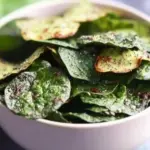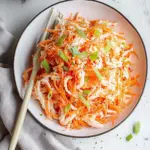These traditional Chilean pumpkin sopaipillas are golden, pillowy discs of fried dough made with mashed pumpkin and flour—served hot with a drizzle of warm chancaca syrup infused with orange peel, cloves, and cinnamon. This dish is a popular street food and rainy day favorite throughout Chile, especially during winter months.
The slightly earthy sweetness of the pumpkin, paired with the sticky spiced syrup, creates an indulgent treat that feels like a hug in every bite. Whether served as an afternoon snack or a sweet ending to a cozy dinner, these sopaipillas offer a comforting taste of South American tradition.
Full Recipe
Ingredients:
-
2 cups cooked and mashed pumpkin (preferably butternut or kabocha)
-
2 ½ cups all-purpose flour
-
2 tablespoons butter, softened
-
1 teaspoon baking powder
-
½ teaspoon salt
-
Vegetable oil, for frying
For the Chancaca Syrup (Miel de Chancaca):
-
1 cup chancaca (or dark brown sugar or panela)
-
1 cup water
-
1 cinnamon stick
-
2 cloves
-
1 strip of orange peel
Directions:
-
In a large bowl, combine the mashed pumpkin, flour, butter, baking powder, and salt. Mix until a smooth dough forms. If it’s sticky, add a little more flour.
-
On a lightly floured surface, roll out the dough to about ¼ inch thickness. Cut into circles using a cookie cutter or glass.
-
In a deep pan, heat vegetable oil over medium heat. Once hot, fry the sopaipillas in batches until golden brown, about 2–3 minutes per side. Drain on paper towels.
-
For the syrup, combine chancaca, water, cinnamon, cloves, and orange peel in a small saucepan. Bring to a boil and simmer for 10–15 minutes until thickened slightly.
-
Strain the syrup to remove spices and peel. Serve the sopaipillas warm with generous drizzles of the hot syrup.
Prep Time: 20 minutes | Cooking Time: 30 minutes | Total Time: 50 minutes
Kcal: 220 kcal | Servings: 6 servings
The Cultural Roots of Chilean Pumpkin Sopaipillas
Chilean pumpkin sopaipillas, or sopaipillas de zapallo, are a beloved traditional dish in Chilean cuisine that dates back centuries. These golden, fried pastries are particularly popular in the southern regions of Chile, where cold and rainy winters demand warm, comforting foods. The origin of sopaipillas traces to Spanish colonization, but the unique addition of pumpkin is a distinctly Chilean twist that evolved over time due to the abundance of squash in the region.
Unlike the thinner, puffier versions of sopaipillas found in other Latin American countries or the American Southwest, the Chilean version incorporates mashed pumpkin into the dough, giving the final product a rich orange hue and a slightly sweet, earthy flavor. This addition not only adds flavor but also enhances the dough’s tenderness and structure.
Sopaipillas as a Rainy Day Comfort Food
In Chile, sopaipillas are widely regarded as a staple comfort food during the cold and wet winter months. You’ll often hear locals refer to them affectionately as “sopaipillas pasadas” when soaked in miel de chancaca — a spiced, dark syrup made from unrefined cane sugar (chancaca), cloves, cinnamon, and orange peel. When the rain starts to pour, it’s common for street vendors and home cooks alike to start frying batches of these golden discs and serving them warm with syrup ladled generously on top.
They evoke a nostalgic memory for many Chileans — of childhood, family, and cozy evenings. Just the smell of sopaipillas frying in oil is enough to transport someone back to their grandmother’s kitchen, where the whole process of preparing the dough, rolling it out, and frying it was a family ritual.
Texture, Flavor, and Appearance
What sets Chilean pumpkin sopaipillas apart is their delightful contrast in texture. On the outside, they’re slightly crispy and golden brown from being fried, while the inside remains soft, moist, and slightly chewy. The pumpkin imparts a natural sweetness that complements the dark, spiced chancaca syrup beautifully. The syrup itself has a robust molasses-like depth with aromatic hints of citrus and clove.
Visually, these sopaipillas are charmingly rustic. Their round shape and warm orange tint make them especially inviting on a cold afternoon. Some versions are pricked with a fork before frying, which prevents puffing and helps them absorb syrup more readily. Others are served puffed and light, perfect for dipping.
Serving Traditions and Variations
Chilean sopaipillas are traditionally served in two main ways: savory or sweet. The sweet version is most commonly enjoyed with miel de chancaca, poured over while warm. This version is more of a dessert or afternoon snack.
However, savory versions are also popular and often served as a side dish with pebre (a spicy Chilean salsa), mustard, or even just a sprinkle of salt. In this form, they might accompany soups or stews or be eaten as a standalone snack.
Some cooks get creative and make mini versions for appetizers or party snacks. Others might add a twist with flavored butters, jams, or drizzles of caramel and chocolate for a more modern take.
Why Pumpkin?
Pumpkin — or more commonly in Chile, zapallo camote — is a native ingredient that’s not only readily available but also adds moisture, color, and nutrients to the dough. The soft texture of cooked pumpkin makes it easy to blend into flour, creating a dough that’s both pliable and rich in flavor. Pumpkin is also a nutritional powerhouse, packed with beta carotene, vitamins, and fiber, making sopaipillas a slightly healthier indulgence than your average fried treat.
The use of pumpkin also speaks to the Chilean philosophy of seasonal, local cooking. Especially in rural areas, home cooks take pride in using ingredients grown in their gardens or bought from nearby farms.
Chancaca: The Signature Syrup
Perhaps the most distinctive feature of the sweet version of sopaipillas is the syrup known as miel de chancaca. This isn’t your average honey — it’s made by simmering raw cane sugar blocks (chancaca or panela) with water, cloves, cinnamon sticks, and orange peel until the mixture becomes thick, dark, and syrupy. The final result is deeply spiced and aromatic, a perfect match for the subtly sweet sopaipillas.
Chancaca syrup has a long tradition in Chilean cooking, used not just for sopaipillas but also for other sweets and pastries. Making it from scratch is part of the charm of this recipe — it fills the house with the scent of cloves and citrus and gives the dish its authentic Chilean soul.
A Social and Culinary Tradition
Preparing sopaipillas is more than just making a snack — it’s often a social ritual. In many households, especially in rural areas, the entire family gathers to help with the dough, roll it out, and take turns frying and flipping the rounds in hot oil. It’s a recipe that invites participation and conversation.
Sopaipillas are often found at Chilean festivals, gatherings, and national celebrations like Fiestas Patrias. They symbolize warmth, togetherness, and a deep-rooted love for local food culture. They’re also an entry point for many foreigners into Chilean cuisine, offering a simple yet delicious way to understand the flavors of the region.
Adapting the Recipe for Other Diets
As global food trends evolve, so do traditional recipes. Many cooks have found ways to adapt sopaipillas for different dietary needs. For example, gluten-free flours can be used with some trial and error to replicate the soft texture. Vegan versions are also easy to create by substituting butter with vegetable oil or margarine, and ensuring the syrup is free of animal-derived ingredients.
Although the classic version is fried, some health-conscious versions are baked instead. While the texture differs slightly — more biscuit-like than crisp — the comforting flavor remains, especially when served warm with syrup or salsa.
Why You Should Try This Dish
Whether you have Chilean roots or are simply curious about Latin American cuisine, pumpkin sopaipillas are a beautiful and approachable recipe. They require minimal, accessible ingredients and no fancy equipment — just flour, pumpkin, and a few pantry staples. The process is fun, especially if shared with family or friends, and the results are both visually stunning and incredibly satisfying.
Even if you’ve never tried chancaca syrup before, it’s a flavor you’re likely to fall in love with. It pairs just as well with pancakes, waffles, and ice cream, making it a great addition to your kitchen repertoire.
Sopaipillas offer a delicious balance of savory and sweet, and their deep roots in Chilean tradition make them more than just a snack — they’re a connection to history, family, and culture.
Conclusion
Chilean pumpkin sopaipillas with chancaca syrup are a heartwarming fusion of simplicity and tradition. They’re a testament to how a handful of humble ingredients — pumpkin, flour, spices, and unrefined sugar — can be transformed into something rich with meaning and flavor.
Perfect as a winter indulgence, a cultural treat, or a cozy dessert for guests, sopaipillas are a must-try dish for anyone looking to explore the essence of Chilean home cooking. More than just a fried pastry, they represent community, warmth, and the magic that happens when comfort food meets cultural heritage.
Whether you’re recreating your grandmother’s recipe or discovering them for the first time, pumpkin sopaipillas are sure to earn a permanent spot in your kitchen.






